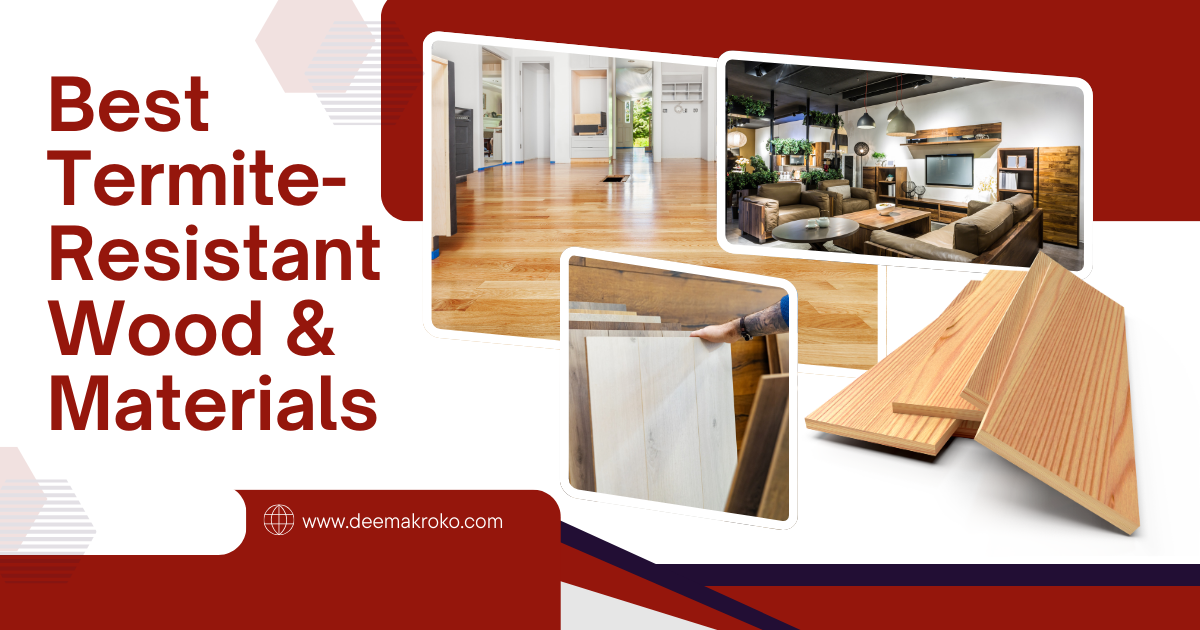Best Termite-Resistant Wood & Materials
Termites are one of the biggest threats to homes in India. These silent destroyers can cause severe damage to wooden structures, furniture, and even the foundation of your home. To protect your home from termites, choosing termite-resistant wood & materials is crucial. In this guide, we will explore the best termite-resistant wood & materials that can keep your home safe and long-lasting.
Why Choose Termite-Resistant Materials
Termite infestation is a common problem in India due to the warm and humid climate, which creates a perfect breeding ground for termites. Once they invade, they can weaken structures, leading to costly repairs. Using termite-resistant wood and materials ensures:
Longevity of wooden structures
Reduced maintenance costs
Increased property value
A safer and pest-free environment
Now, let’s dive into the best termite-resistant wood options and alternative materials for Indian homes.
Best Termite-Resistant Wood for Indian Homes
1. Teak Wood (Sagwan)
Teak is one of the most durable and termite-resistant woods available in India. It contains natural oils that repel termites, making it a popular choice for furniture, doors, and flooring.
Pros: High durability, water-resistant, aesthetically pleasing
Cons: Expensive, requires proper seasoning
Best Used For: Furniture, doors, flooring, window frames
2. Sal Wood
Sal wood is known for its high strength and resistance to termites. It is commonly used in construction for beams, doors, and frames.
Pros: Highly durable, resistant to decay, strong
Cons: Difficult to work with due to hardness, costly
Best Used For: Structural components, door frames, flooring
3. Cedar Wood
Cedar has natural oils that make it resistant to termites and other pests. It is also highly durable and used for both indoor and outdoor applications.
Pros: Natural termite resistance, strong aroma repels pests, lightweight
Cons: Costly, limited availability in India
Best Used For: Furniture, closets, paneling
4. Mahogany Wood
Mahogany is another excellent choice for termite-resistant wood. Its dense composition and natural oils make it less attractive to termites.
Pros: High durability, beautiful reddish color, resistant to rot
Cons: Expensive, requires maintenance
Best Used For: Luxury furniture, doors, paneling
5. Neem Wood
Neem wood is well-known for its medicinal properties and termite resistance. It is a great option for furniture and home construction.
Pros: Eco-friendly, affordable, anti-fungal and anti-termite properties
Cons: Less durable than teak, needs proper seasoning
Best Used For: Furniture, door frames, wooden carvings
Alternative Termite-Resistant Materials
While wood remains a popular choice, there are alternative materials that are completely termite-proof. Here are some options:
1. WPC (Wood Plastic Composite)
WPC is a mixture of wood fibers and plastic, offering durability and termite resistance.
Pros: Waterproof, eco-friendly, resistant to termites and rot
Cons: Slightly expensive, limited designs compared to natural wood
Best Used For: Flooring, wall paneling, doors
2. Plywood with Anti-Termite Treatment
High-quality plywood treated with anti-termite chemicals offers great resistance against termite attacks.
Pros: Cost-effective, readily available, customizable
Cons: Requires proper chemical treatment, durability varies
Best Used For: Furniture, cabinets, partitions
3. Aluminum & Steel Frames
Metals like aluminum and steel are 100% termite-proof, making them ideal for doors and windows.
Pros: Highly durable, weather-resistant, no risk of termites
Cons: Industrial look, higher initial investment
Best Used For: Window frames, door frames, structural beams
4. Concrete & Cement Board
Concrete and cement boards are becoming popular alternatives to wood. They are durable, fire-resistant, and completely termite-proof.
Pros: Highly resistant to pests and moisture, strong structure
Cons: Heavy, less aesthetic appeal compared to wood
Best Used For: Walls, ceilings, flooring
5. Fiber Cement Boards
Made from a mix of cement and cellulose fibers, fiber cement boards are durable and resistant to termites.
Pros: Fire-resistant, weatherproof, no maintenance required
Cons: Limited design options, requires skilled installation
Best Used For: Wall cladding, partitions, ceilings
Tips to Prevent Termite Infestation
Even with termite-resistant materials, prevention is always better than cure. Here are some additional tips to keep termites away:
Regular Pest Control Inspections: Hire professionals for periodic termite inspections.
Proper Wood Seasoning & Treatment: Use seasoned and chemically treated wood for added protection.
Maintain Dry Conditions: Termites thrive in moisture, so ensure proper ventilation.
Use Borate Treatment: Applying borate solutions on wood before painting can deter termites.
Seal Cracks & Gaps: Prevent termites from entering through tiny cracks in walls and floors.
Avoid Direct Contact Between Wood & Soil: Keep wooden structures elevated and protected from the ground.
Apply Anti-Termite Coatings: Use specialized coatings and sprays for added protection.
Conclusion
Choosing the right termite-resistant wood and alternative materials can protect your home from costly termite damage. While teak, sal, cedar, and mahogany are excellent choices, modern alternatives like WPC, aluminum, and fiber cement boards offer enhanced durability. By incorporating these materials and following termite prevention tips, you can ensure a long-lasting, termite-free home in India.
Do you need expert guidance on termite-proofing your home? Contact professional termite control services today and safeguard your investment!

